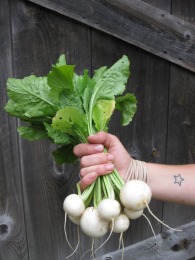These may be this week's unusual vegetables.
Escarole
 Escarole is a variety of endive whose leaves are broader, paler and less bitter than other members of the endive family. In taste -- but not color -- it is almost indistinguishable from radicchio.
Escarole is a variety of endive whose leaves are broader, paler and less bitter than other members of the endive family. In taste -- but not color -- it is almost indistinguishable from radicchio.
High in folic acid, fiber, and vitamins A and K, escarole can be eaten raw or gently cooked. Try tossing a few escarole leaves into a mild salad, serving some quickly wilted with lemon juice, or stir chopped escarole into soup.
Salad Turnips

We keep these under row cover to keep them bug and worm-free.
Flavor: Similar to a radish, the salad turnip is earthy, crunchy and peppery.
Benefits: Just like the radish, salad turnips are rich in Vitamin C, folic acid, and potassium as well as low in calories and high in dietary fiber. Turnip greens are highly nutritious, even more so than the roots. They are high in antioxidants like vitamin A, vitamin C, vitamin K, carotenoids xanthins and lutein. Top greens are also an excellent source of the B-complex group of vitamins. The greens are also rich in important minerals like calcium, copper, iron and manganese.
Storage Tips: The leaves cause moisture loss during storage, so it is best to remove tops and store the root and greens separately in the refrigerator.
Preparation and Cooking: Enjoy salad turnips as you would radishes in fresh salads and relishes. Salad turnips can also be thinly sliced and sauteed, or pickled with other vegetables. I also like to cook turnips and mash them with garlic, butter and salt.
The greens can be cooked up, too! They are really looking nice.
DAIKON RADISHES
 Daikon is is root vegetable said to have originated in the Mediterranean and brought to China for cultivation around 500 B.C. This is an extremely versatile vegetable that can be eaten raw in salads or cut into strips or chips for relish trays. It also can be stir-fried, grilled, baked, boiled or broiled. Use the daikon as you would any radish.
Daikon is is root vegetable said to have originated in the Mediterranean and brought to China for cultivation around 500 B.C. This is an extremely versatile vegetable that can be eaten raw in salads or cut into strips or chips for relish trays. It also can be stir-fried, grilled, baked, boiled or broiled. Use the daikon as you would any radish.
Storage - Chinese radishes will keep well in the refrigerator if they are placed in a sealed container or plastic bag in order to maintain high humidity.
Preparation - To prepare, peel skin as you would a carrot and cut for whatever style your recipe idea calls for.
Nutrition Information - Daikon is very low in calories. A 3 ounce serving contains only 18 calories and provides 34 percent of the RDA for vitamin C. Rich in vitamin C, daikon contains active enzymes that aid digestion, particularly of starchy foods.
Easy Daikon Salad serves 2
1 cup julienne cut daikon radish (I used my food processor to cut it)
1/2 tbsp seasoned rice vinegar
1 tsp granulated sugar
1 tsp sweet rice wine (mirin)
OPTIONAL: crushed peanuts
Place the daikon in a colander/mesh strainer over a bowl or the sink and sprinkle with salt. Mix well. Let sit for 30 minutes. Squeeze out excess water and then rinse well with cold water. Drain.
In a small saucepan, combine the seasoned rice vinegar, sugar and rice wine. Cook over medium heat, stirring constantly, until the sugar dissolves (this will only take a few minutes).
Transfer the daikon to an airtight container and pour the rice vinegar mixture over. Shake or stir well to combine. Chill for 20 minutes before serving.
This can store for up to a few days in the fridge, if it lasts that long. If desired, serve topped with crushed peanuts.


